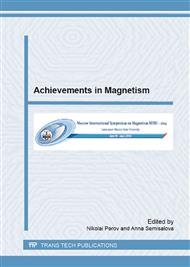p.64
p.68
p.73
p.79
p.82
p.86
p.93
p.97
p.101
Autoresonant Excitation of Spin Wave "Dark" Solitons
Abstract:
In this paper we propose a method to generate pure dark solitons by a periodic external field with a slowly varying frequency, which allows to control amplitude of the excited solitons and period of soliton trains. Our approach to generate dark solitons is based on the effect of autoresonance when the excited wave is phase-locked by the drive after the crossing the resonance. The resonant frequency and the threshold condition on the amplitude of the driving were found.
Info:
Periodical:
Pages:
82-85
Citation:
Online since:
July 2015
Authors:
Keywords:
Price:
Сopyright:
© 2015 Trans Tech Publications Ltd. All Rights Reserved
Share:
Citation:


